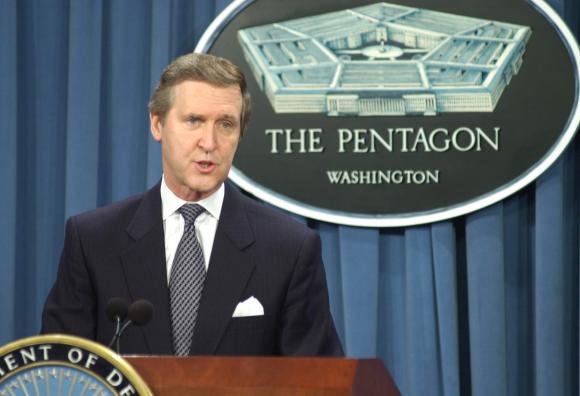By Everett C. Dolman
 The American military is infatuated with the latest business models and their potential application for war. Bureaucracies are not agile organizations, as a rule, and just as the Pentagon institutes the previous decade’s top-selling business management method, it seems corporate America has already moved on to the Next Big Thing. A list of the 25 top-selling business management books, sorted by publication date, reads like a slightly delayed litany of ideal business-to-war manifestos.[1] Nonetheless, in his most recent memorandum, Secretary of Defense Jim Mattis echoed many of his predecessors in encouraging all members of the military to “bring business reforms to the Department of Defense.”
The American military is infatuated with the latest business models and their potential application for war. Bureaucracies are not agile organizations, as a rule, and just as the Pentagon institutes the previous decade’s top-selling business management method, it seems corporate America has already moved on to the Next Big Thing. A list of the 25 top-selling business management books, sorted by publication date, reads like a slightly delayed litany of ideal business-to-war manifestos.[1] Nonetheless, in his most recent memorandum, Secretary of Defense Jim Mattis echoed many of his predecessors in encouraging all members of the military to “bring business reforms to the Department of Defense.”
Secretary Mattis follows a long line of similar efforts. Secretary of Defense Robert McNamara (1961-67) directly inserted systems analysis business practices developed while at Ford Motor Company into both weapons acquisition programs and war-planning/assessment models in an effort to increase military efficiency during the Vietnam War, with at least equivocal results in military effectiveness.[3] Secretary William Cohen (1997-2001) similarly directed the Pentagon to initiate a revolution in military affairs (RMA) based on an ongoing “revolution in business affairs” to “streamline, … downsize, [and] outsource” for improved efficiency.[4] Secretary Donald Rumsfeld (1975-77, 2001-06), who served as the CEO of three major corporations between stints in government, transferred then-popular business modelling of information systems into the military through a process called transformation.[5] Secretary Chuck Hagel (2013-15), in announcing the Defense Innovation Initiative (DII), flatly asserted that the Department of Defense “must embrace better business practices that are core to any modern enterprise, private or public.”[6]
In the process, the U.S. military suffered through near constant reorganization. A few of the more notorious efforts, in no particular order, include Best Practices Reengineering (BPR), Total Quality Management (TQM), Management by Objective (MBO), Core Competency, Balanced Scorecard (BSC), Matrix Management, Emotional Intelligence, One-Minute Management, and Lean Six Sigma. None have lasted, and neither are future efforts along these lines likely to do so.
The point is not that the U.S. military should more critically assess or find the right business management model, but to question whether any business model is appropriate for military operations and planning. The assessment here is they are not.
This is because business models rely on adapting to shifting market conditions to find profitable supply and demand niches. While many have proven useful, they remain, in essence, context-constrained tools for assessing success and failure when a precise calibrator, called money, is the appropriate measuring device. They work for business because the purpose of business is to maximize profit. This is not, nor should it be, the purpose of the U.S. military.
There are three essential components essential to any business model:
What is the product or service for sale?
Who is the customer?
Who are the owners or shareholders receiving the profits or suffering the losses?
Unfortunately, these are either entirely absent or misapplied when extended by analogy to the military. The problem of applying business models to the Defense Department occurs in the process of transferring methods of successful business intact into organizations that should not offer themselves to the highest bidder and at least ought not be motivated by monetary profit. These organizations are generally understood to provide a common or collective good, and include most of the functions of government such as military and police protection, public education, and infrastructure investment, among others.[7]
This is not to say organizations intended to provide social or collective goods cannot learn from business models to enhance their efficiency and reduce waste—it is simply that effectiveness is measured differently in war and the preparation for war than in business, and effectiveness is the first casualty of over-emphasizing monetary efficiency over organizational purpose.[8]
Governments, most emphatically including their militaries, public universities, and the like tend to become perverted when they attempt to transform themselves into for profit organizations.
A military organization, when established in support of the state’s claim on a monopoly of legitimate violence in international relations, is not nor should it be a for-profit mercenary force. Pay for service can be profitable and valuable in piece-work manufacturing or other non-violent market transactions, but is notoriously counter-productive when the customer is a non-voluntary tax-paying citizen.[9]
To illustrate from another (normally) government function, paying firefighters for the number of fires extinguished tends to radically increase the number of fires in a given municipality. When firefighters are salaried, however, with a constant revenue source for infrastructure support, fire prevention takes precedence. Community outreach to teach best practices, home and business safety inspections, and the like take precedence in the periods between fewer and fewer fires. Ideally, the fire department is most effective when no fires occur.
Similarly, paying the military for how many sorties are flown, how many enemies are killed (the notorious body-count fallacy of Vietnam), or simply how many wars are fought and/or won, creates perverse incentives to increase the number of sorties, casualties, and even wars, respectively.[10] A strong military should be judged on the number of wars it deters, and when it does enter into combat, on how quickly and effectively—that is, the extent to which the political purpose of entering into the conflict is achieved—those conflicts are closed out.
So, what is the product or service the American military has for sale? Is it war? That seems a little absurd. Any time the nation is not at war the military is not performing its function. The days of war-making for loot, booty, or other treasure, much less for territorial gain, have been de-legitimized since at least 1945. Is the service provided security from foreign aggression? Perhaps, but then we can liken it to the business of insurance, and this introduces the dilemma of the so-called moral hazard. Many people act more recklessly when fully insured and thus insulated from responsibility for their actions. The 1980s Savings and Loan crisis and the 2009 subprime mortgage collapse have been directly correlated to guaranteed Federal bailouts for under-performing financial institutions.[11] Governments may be similarly aggressive when underwritten by a strong military.[12] Aside from the difficulties of moral hazard, the insurance analogy requires resolution of the problem of profit motive. Private insurance companies can and do make a profit—a lot of it—but they do so by not insuring those who arguably need insurance the most, those who are the most likely to file a claim and those who cannot afford to pay. This is why the government subsidizes the least profitable insurance markets. For those who are essentially uninsurable medically, the elderly and those with expensive pre-existing conditions, the U.S. provides Medicare and Medicaid. To protect those who lose their jobs through no fault of their own, the government requires businesses to pay into an unemployment insurance fund, and manages the fund independently. None of these programs are—or should be—assessed upon their profitability.
Which raises the question, “Who is the customer for America’s military?” Is it the U.S. citizenry? If so, then why is the customer forced under penalty of imprisonment to pay for the service it receives in the form of taxes? Fee-for-service plans can be quite profitable for cell phones, Internet and television access, garbage collection, and more, but these are all voluntary. The customer who is dissatisfied can switch to another provider or forego the service entirely. Businesses must perform to maintain market share. There is no equivalency for a military that provides a conventional or nuclear deterrent for all citizens of the state. The customer/citizen cannot opt out, and elect to forego paying taxes for that particular service.[13] If on the other hand the customer is the federal government we are faced with an even bigger paradox when employing a business management model. Profitability is not the proper measurement—breadth of coverage, a moral responsibility, is.
ONE CANNOT BE BOTH THE CUSTOMER AND THE RECIPIENT OF THE CUSTOMER’S MONEY (THE PURVEYOR) WITHOUT STRESSING THE MOST GENEROUS LOGIC OF BUSINESS MANAGEMENT.
Who is the owner, or shareholder, of the American military entitled to its profits? Is it the government? Or, like the question above, is it the tax-paying citizen? One cannot be both the customer and the recipient of the customer’s money (the purveyor) without stressing the most generous logic of business management. A business that has itself as its sole customer is not really making money. A bar owner, for example, who is his only customer, will drink his way to bankruptcy. And yet the U.S. Government plays a similar game with its employees. Military members and government workers are paid by the government, which receives revenue from (among other things) taxes on income. Each serviceman and woman receives a statement of pay that lists the amount of federal taxes withheld. Of course, federal taxes are what pays the salary of the service member, and so this is actually a statement of how much tax would have been withheld if the service member’s pay came from some source other than the government. It’s a stylized kabuki dance. Now, if the U.S. Government accepted payment from other countries or organizations for military actions taken on their behalf, and the service member’s pay was based solely on such external revenue, then we could no longer legitimately call our professional military a service. We would be back to calling our soldiers, sailors, and airmen mercenaries-for-hire. Of course, then we should use business management models to efficiently maximize revenue.
Perhaps the real beneficiary is business itself. More and more of the Pentagon’s budget is going to private companies supporting the military mission. In 2004, the Pentagon had more than $200 billion in contracts for non-combat support (base maintenance, food service, housing, recreation, and more), a number that has grown substantially since.[14] Weapons sales are booming, as the faster munitions are expended, the faster they need to be replaced. For the first time in its history, America seems committed to a never-ending state of war. Since 1990, for example, the U.S. Air Force has been continuously flying missions over the Middle East. As the old saw goes: “War is business, and business is good.” And if the war business is good, why not make it permanent?

U.S. Soldier in Afghanistan (U.S. Government Photo)
The ultimate question begged by these musings is to consider what effect more than fifty years of trying to implement business management models into the American military has had? Are we more efficient and monetarily lean than ever before? It doesn’t seem so. We have the world’s most expensive military, with the costliest equipment and highest operating margins. It is difficult to draw a direct causal argument, despite the apparent correlation in time, and beyond the scope of this article to do so. The argument is simply that military effectiveness is a matter that ought not to be judged by monetary value (profit or cost-savings efficiency) of the services performed, and it is thus not appropriate for business management models. More bluntly, whenever a public organization (as opposed to a private one) is so conceived the result will be unavoidably perverse.
No comments:
Post a Comment